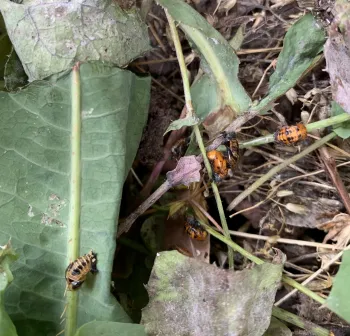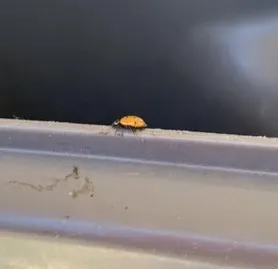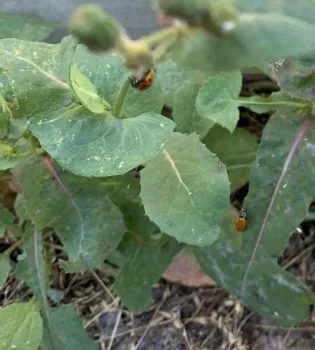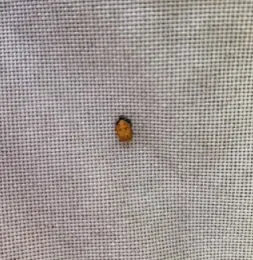
Article by Cheri Meyers -
As a recent graduate of the UC Master Gardener Program of Yolo County, this is my first attempt to share my gardening experiences in the Yolo Gardener Newsletter and Savvy Sage Blog. I hope you find it worth the read.
It’s a lovely but warm spring day here in West Sacramento. I should be shouldering through the heat to work in my yard but I’m just not ready for that type of shock yet, so I’ll sit in my nominally cooler house and write about my yard instead. I’m too stubborn to pay the power company for air conditioning this early in the season and I’m starting to feel the heat radiating from my laptop so I may need to make this quick.
When we left our small, zero-lot line home with a postage-sized backyard seventeen years ago and moved into our brand-spanking new home, I loved the new floor plan, the new location within West Sacramento, and the fact that there is only one other home immediately nearby (and even that is separated from us by very wide side yards on both properties). The location is perfect because I didn’t want to feel closed-in like we were before. Most of all, I loved that the back yard here is about four times larger than the back yard on our previous property, and I wanted to have the garden of my dreams—or at least a backyard I could enjoy with family and friends.
We moved here in the month of November. I happily focused on the inside of the house those first several months of winter. It really didn’t occur to me to look out into the back yard until the weather cleared a bit. I have made many mistakes with our backyard, but that was probably the first. By the time I did venture out, all I saw were two tiny cement pads (one at the sliding patio door, and the other at the door from the garage to one of the side yards) surrounded by an immense sea of tall weeds growing out of drying mud.

We didn’t have the money to hire professionals to design or install landscaping in the backyard. Although I didn’t know much about gardening or landscaping, I did know that I wasn’t ever going to use chemical weed killers (e.g., glyphosate). So, I started pulling weeds. By hand. The entire yard. That was my second mistake. To this day my hands still remind me of the torture I put them through.
I spent day after day out there under the Sacramento Valley sun, with my wide-brimmed hat and pair after pair of gardening gloves. It was hard, back-breaking work, but my relative youth and lack of smarts kept me going. Not unexpectedly, all that hard work was ultimately rewarding and satisfying.
By the next fall and winter, I still didn’t know much about plants, landscaping, or what I wanted in the yard, so I ended up repeating all the hand weeding again that spring. By our third spring in the new house, I finally got the courage to just pick a starting point and begin laying out something resembling landscaping. My main goal was to get something, pretty much anything, in the ground to prevent the weeds from taking over again. Fortunately, a big box store opened nearby so what seemed like zillions of trips to the garden center didn’t take forever. I continued building upon each small step year after year, until we had what could pass for an inhabitable back yard. We also finally bit the bullet and had a concrete patio poured and a lovely patio cover installed.

I am enormously proud of what I’ve built, even though much of it looks “homemade.” Unfortunately, however, it is a lot of work to keep up, primarily due to two of my initial limitations: first, I didn’t have the knowledge or wherewithal to install irrigation; and second, I didn’t have the strength or energy to dig out enough soil when laying stepping stones and pavers so the surrounding mulch (bark) is only an inch or so deep. There’s a third limitation regarding my choice of mulch, but I’ll leave that story for another time.
For the first issue, I deal with the hand-watering as best I can. On most watering days I enjoy spending time visiting each area of my yard and in some cases, each plant. Now, thanks to the Master Gardeners I’ve met, I plan to install drip irrigation eventually. (I would never name names but bet my friend Maureen’s ears are burning 😊). We’ll see if that plan ever gets off the ground (pun intended).
For the second issue, the net result is that every spring, there are several areas in the yard where I am, again, unfortunately, pulling a tremendous number of weeds by hand. I’ve purchased some tools that help but I spend a lot of time eye to eye with, to name just a few (ok, more like many): groundsel, horseweed, thistles, burclover, filaree, spurge, the ever-present bindweed, and the current bane of my existence, catchweed bedstraw.
There were times when I would start pulling all those weeds and then notice multitudes of lady beetles trying to escape my handiwork. All my life, I’ve never wanted to harm a lady beetle intentionally, and I hope that is a kindness all children learn and carry into adulthood. But I had no idea how helpful lady beetles are in a garden when the dreaded you-know-what’s arrive: aphids. I suppose I should be thankful that I knew nothing about why there were so many lady beetles and how infested those weeds were with aphids, or I might have turned tail and run into the house. I also didn’t realize how those aphids might next tackle some of my landscape plants.
But now I know. Of all the interesting and useful information presented in the Master Gardener classes, one thing that made a lasting impression on me is just how beneficial lady beetles are. They love to eat aphids like I love to eat chocolate. Well, I don’t like green and squishy chocolate, but I’d say the comparison still holds.

Lady beetle larvae and adults devour aphids like nobody’s business. And in a world where Integrated Pest Management (IPM) is ever more important, those colorful and cheery lady beetles can mean the difference between using harmful pesticides or protecting our environment by letting nature take its own course.
My weed season has begun. I’m almost ashamed of how I’ve let the yard go this year, but I will tackle it like I usually do. At least this year, I know that the scary
black and orange crawly things hanging out in my weeds are lady beetle larvae and the funny-looking stationary lady beetle-like creatures stuck to my patio furniture covers and other garden surfaces are lady beetle pupae. Now I am even more careful to save as many lady beetles, young and old, as possible.
I inspect every weed for mobile lady beetle larvae and adults, and I relocate them to a patch of aphid-covered weeds that I will postpone pulling until last. When I spot the immobile pupae on weed leaf or stem, instead of tossing the whole weed into the municipal yard waste bin, I gently detach the affected plant part and tuck it under and amongst the weed patch I’m saving, now affectionately named my “lady beetle nursery.” And just to be sure, I leave my yard waste bin in the shade with the lid open so that any adult or juvenile lady beetles I accidentally toss into the bin can eventually find their way out.
Saving the lady beetles in my backyard this way makes cleaning up the yard even more of a slow and tedious chore than simply plowing through the weeds. But again, not unexpectedly, I find it even more amazingly rewarding and satisfying.
All photos by Cheri Meyers, adapted.

